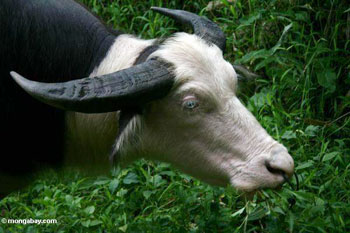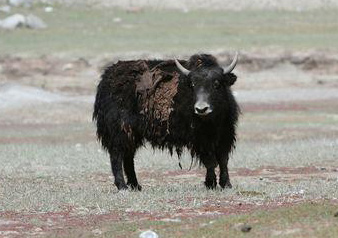Loss of livestock breeds put food supplies at risk in poor countries
Loss of livestock breeds put food supplies at risk in poor countries
mongabay.com
September 3, 2007
|
|
A number of rare livestock breeds face extinction, a prospects the weakens genetic diversity and could be the food supply at risk in some parts of the world, warns a new report from the Consultative Group on International Agricultural Research (CGIAR). The group calls for the immediate establishment of genebanks to conserve reproductive material from the most threatened breeds.
CGIAR says the over-reliance on just a few breeds of a handful of farm animal species, such as high-milk-yielding Holstein-Friesian cows, egg-laying White Leghorn chickens, and fast-growing Large White pigs, is causing the loss of an average of one livestock breed every month according to a report recently released by the UN Food and Agriculture Organization (FAO).
The report, “The State of the World’s Animal Genetic Resources,” surveyed farm animals in 169 countries and found that nearly 70 percent of the world’s remaining livestock breeds live in developing countries.

|
“Valuable breeds are disappearing at an alarming rate,” said Carlos Seré, Director General of the International Livestock Research Institute (ILRI), a group that contributed to the research. “In many cases we will not even know the true value of an existing breed until it’s already gone. This is why we need to act now to conserve what’s left by putting them in genebanks.”
In a keynote speech at the scientific forum on the opening day of the First International Technical Conference on Animal Genetic Resources in Interlaken, Switzerland, Seré called for the rapid establishment of genebanks in Africa as the first of four practical steps to “better characterize, use, and conserve the genetic basis of farm animals for the livestock production systems around the world.”
“This is a major step in the right direction,” said Seré. “The international community is beginning to appreciate the seriousness of this loss of livestock genetic diversity. FAO is leading inter-governmental processes to better manage these resources. These negotiations will take time to bear fruit. Meanwhile, some activities can be started now to help save breeds that are most at risk.”
The report says that the trend towards homogenization in recent years results from smallholder farmers abandoning their traditional animals in favor of higher yielding stock imported from western countries. Reduced genetic diversity is significant because it leaves livestock less able to adapt to change. For example, the report cites Uganda’s indigenous Ankole cattle: “During a recent drought, some farmers that had kept their hardy Ankole were able to walk them long distances to water sources while those who had traded the Ankole for imported breeds lost their entire herds.” Nevertheless, Ankole face extinction within 20 years due to replacement by high milk-yielding Holstein-Friesians, which are now found in 128 countries around the world.

|
Seré says that while ubiquitous animal breeds “offer short-term benefits to their owners because they promise high volumes of meat, milk, or eggs… they also pose a high risk because many of these breeds cannot cope with unpredictable fluctuations in the environment or disease outbreaks when introduced into more demanding environments in the developing world.”
Seré proposed four steps to better manage farm animal genetic resources: maintaining a variety of indigenous breeds on farms; allowing greater mobility of livestock breeds across national borders to avoid disease outbreaks and natural disasters; using “landscape genomics” to map what breeds are best suited to which environments and circumstances around the world; and establishing genebanks to store semen, eggs, and embryos of farm animals.
“In the US, Europe, China, India, and South America, there are well-established genebanks actively preserving regional livestock diversity,” said Seré. “Sadly, Africa has been left wanting and that absence is sorely felt right now because this is one of the regions with the richest remaining diversity and is likely to be a hotspot of breed losses in this century.”
The State of the World’s Animal Genetic Resources
This article is based on a news release from the International Livestock Research Institute